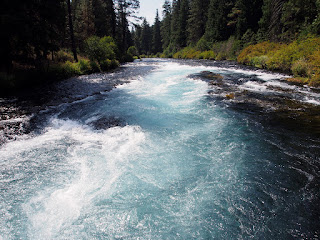 One of the places I had on my wildflower radar for this summer, was Crater Lake National Park. Most sources seemed to agree that in a typical year, the third week of July is the best time to see the most variety of blooming flowers at the park. This is also when the Castle Crest wildflower trail should look its best. However, this summer was not typical, so the Crater Lake snow melted earlier and peak bloom was sooner than usual. In addition, trying to get rooms in the park is an exercise in futility, unless you book about a year in advance. We did finally manage to get some rooms at the Mazama Cabins for mid August, which we were glad to land - even though it was past the peak bloom!
One of the places I had on my wildflower radar for this summer, was Crater Lake National Park. Most sources seemed to agree that in a typical year, the third week of July is the best time to see the most variety of blooming flowers at the park. This is also when the Castle Crest wildflower trail should look its best. However, this summer was not typical, so the Crater Lake snow melted earlier and peak bloom was sooner than usual. In addition, trying to get rooms in the park is an exercise in futility, unless you book about a year in advance. We did finally manage to get some rooms at the Mazama Cabins for mid August, which we were glad to land - even though it was past the peak bloom!After our incredibly relaxing stay at Camp Sherman, we drove south to the park, which is an interesting trip through high desert volcanic geology, ponderosa pines, lodgepole pines, juniper, and miles of dry conditions. We knew there was a fire burning near the north end of the park, so were not surprised to find smoke as we approached the entrance. The sky was kind of yellow-orange all along highway 138. Fortunately, near the rim, we got beyond most of the thick smoke, so the views of the lake were enjoyable.
 |
| On the East Rim, 8-15-2015 |
Staying at the Mazama Village cabins was kind of a cross between camping and a 1950's era motel. No frills rooms, but nicely remodeled and with good showers! And you get a free bag of ice when you check in for your cooler (no fridge!). The beds were quite comfy and we would have enjoyed them more if our neighbors had not risen at 6 AM to pack up to head out...
Here's a quick overview of our flower findings, including a look at two rabbit-named plants. For the rest of the trip photos, see the link below.
 |
| Lewis Monkeyflower (Mimulus lewisii) |
 |
| Common Monkeyflower (Mimulus guttatus) |
 |
| Possible White Monkeyflower? - ID TBD |
 |
| Mountain Blue Penstomon (Penstemon laetus) Likely ID, but not certain. |
 |
| Scarlet Gilia (Gilia aggregata) |
When we first visited the high desert in central Oregon years ago, we saw acres of a weedy looking shrub with yellow flowers. We asked various locals what it was; some said Rabbit Bush, and others said Rabbit Brush; and some even said Yellow sage, which is understandable, but incorrect. Here's what we now know about these plants:
Rabbitbush (Ericameria bloomeri). These plants were growing and blooming
along highway 138 for several miles, going into the park, as well as in
the park, in sunny, open spaces. Most were less than one foot tall.
along highway 138 for several miles, going into the park, as well as in
the park, in sunny, open spaces. Most were less than one foot tall.
Rabbitbrush (Ericameria nauseosa). We only saw a few of these in the
park. Last September, near Sunriver, acres of them were blooming in the open
areas of the forest. Note how the blooms do actually look like a brush.
They can grow over four feet tall.
 |
| Alpine Buckwheat (Eriogonum pyrolifolium) |
 |
| Columbia Monkshood (Aconitum columbianum) |
 |
| Pearly Everlasting (Anaphalis margaritacea) |























